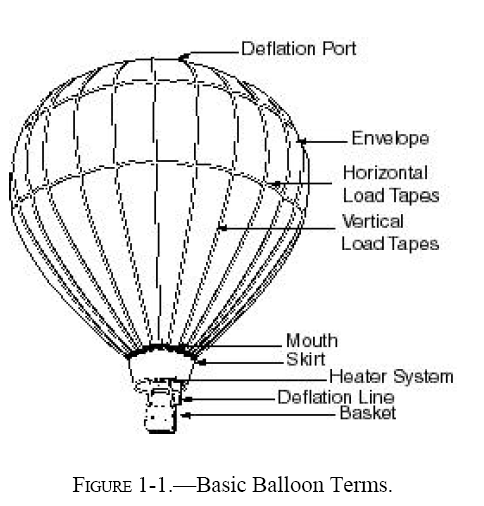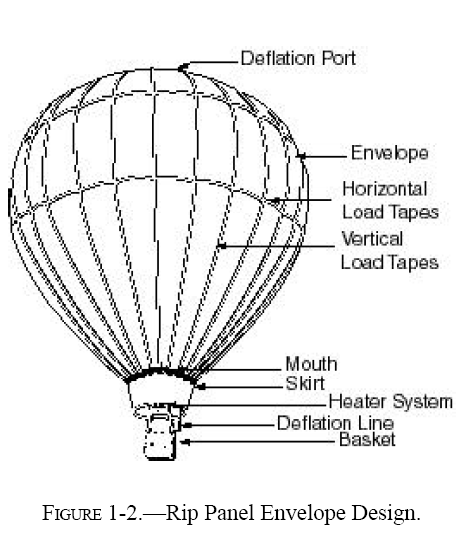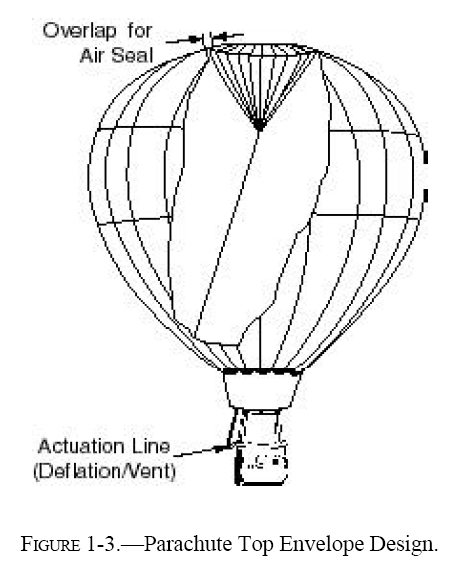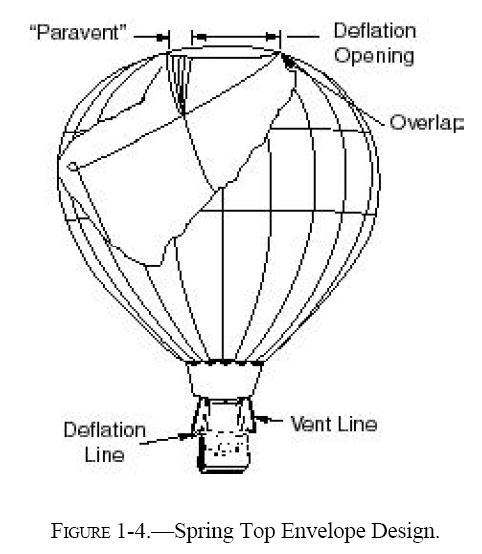BASIC BALLOON TERMS
Balloon terms vary because proprietary terms and
foreign terms have entered the language of
ballooning. However, consistency in terminology
is important because it makes it easier for the pilot,
crew, and passengers to communicate with each
other. The most common terms are used in the text
and in the generic illustrations (refer to figure 1-1)
in this handbook. Terms and names used by
manufacturers are also included. The glossary
contains balloon and aeronautical terms.

BALLOON COMPONENTS
A hot air balloon consists of three main
components: envelope, heater system, and basket.
Envelope
The envelope is the fabric portion of the balloon
containing the hot air and is usually made of nylon.
The deflation port is located at the top of the
envelope and allows for the controlled release of
hot air. It is covered by the deflation panel
sometimes called a top cap, parachute top, or spring top (refer to figures 1-2, 1-3, and 1-4). In a balloon
with a parachute top, partial opening of the
parachute valve is the normal way to cool the
balloon. Balloons with other types of deflation
panels may have a cooling vent in the side or the
top.
 

Heater System
The heater system consists of one or more burners
that burn propane, fuel tanks that store liquid
propane, and fuel lines that carry the propane from
the tanks to the burners. The burners convert cold
(or ambient) air into hot air, which in turn provides
the lift required for flight.
Basket
The basket (usually made of wickerwork rattan)
contains the fuel tanks, instruments, pilot, and
passengers.
SUPPORT EQUIPMENT
Standard support equipment for ballooning is a an
inflation fan, transport/chase vehicle, and small
miscellaneous items, such as igniters, drop lines,
gloves, spare parts, and helmets.
Inflation Fan
Fans come in different styles and sizes. Your
finances, style of inflation, and size of the balloon
will determine the best fan for you.
- Weight—Someone will have to lift the fan into
and out of the transport vehicle. Wheels do not help
with the weight and are not helpful on soft ground.
One person can carry a small fan, but a larger fan
may take two people.
- Safety—Fan blades today can be wood,
aluminum, fiberglass, or composite, with wood
being the most popular. Wood or aluminum blades
designed specifically for balloon fan use are best.
The fan should have a cowling of fiberglass or
metal. A cage or grill alone is not sufficient to
contain rocks or pieces of blade.
- Transport—Space available in a pickup truck,
the back of a van, or on a trailer may determine the
size of the fan.
- Cubic Feet Per Minute (CFM)—Fan blade
design, duct design, and engine speed determine
the amount of air moved in a given time. Do not
confuse engine size with CFM. Larger engines do
not necessarily push more air. Moving a high
volume of air is not necessarily the ultimate goal
in fan performance. Some people prefer a slower
cold inflation to allow for a thorough preflight
inspection.
- Fan Maintenance—The inflation fan is the
most dangerous piece of equipment in ballooning.
A good fan requires little maintenance and should
be easy to maintain. Check the oil periodically and
change it once a year. Check hub bolts and grill
screws for tightness on a regular basis.
- Fuel—Gasoline smells, spills, pollutes, and
degrades in storage. Do not store gasoline in the
fan due to fire hazard and the formation of varnish,
which can clog fuel passages. Some gasoline fans
can be converted to propane. Propane is clean,
stores in a sealed tank, and does not change with
age.
|

